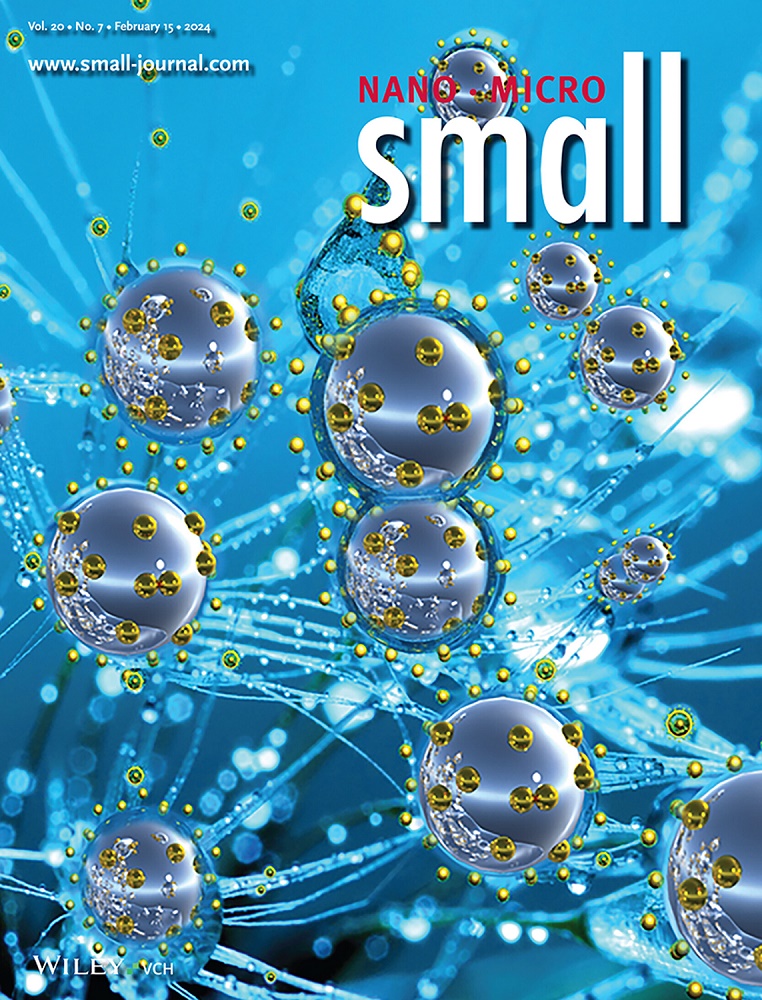DPP-DTT Nanowire Phototransistors for Optoelectronic Synapses in EMG and ECG Signal Classification.
IF 12.1
2区 材料科学
Q1 CHEMISTRY, MULTIDISCIPLINARY
引用次数: 0
Abstract
A neuromorphic phototransistor based on nanowire-patterned diketopyrrolo-pyrrole-dithienylthieno[3,2-b]thiophene (DPP-DTT) is reported. The nanowires, well-aligned with a width of 460 nm, spacing of 8-11 µm, and height of ≈80 nm, are fabricated using the stamping method of soft lithography and exhibit optically stimulated synaptic behavior. Under blue illumination (455 nm, 0.55 mW cm-2), a photogating effect arises at the DPP-DTT/SiO2 interface, leading to threshold voltage shifts up to 6.4 V as a result of electron trapping at the interface. Negative gate pulses (-7 V) facilitate recombination of the trapped electrons, inducing detrapping and consequently leading to a decrease in the threshold voltage. These two behaviors effectively emulate the processes of potentiation and depression. Efficient trap-detrapping dynamics are facilitated by the unique geometry of the nanowire. Synaptic plasticity is modulated by adjusting stimulus intensity (light pulse: 0.26-1.42 mW cm-2, gate pulse: -6--9 V), duration (0.3-2.1 s), frequency (0.47-3.33 Hz), and repetition (1-40 cycles), supporting transitions from short- to long-term behavior. The device is evaluated through artificial intelligence classification tasks, including image recognition and time-dependent physiological analysis. It achieves the classification accuracies of 97.4% for MNIST, 93.4% for electromyography (7 classes), 89.0% for electrocardiography (5 classes), and 83.8% for CIFAR-10.DPP-DTT纳米线光电晶体管在肌电和心电信号分类中的应用。
报道了一种基于二酮吡咯-吡咯-二噻吩[3,2-b]噻吩(DPP-DTT)纳米线图的神经形态光电晶体管。采用软光刻的冲压方法制备了宽度为460 nm、间距为8-11 μ m、高度约为80 nm的纳米线,并表现出光刺激突触行为。在蓝色照明(455nm, 0.55 mW cm-2)下,DPP-DTT/SiO2界面产生光控效应,由于界面处的电子捕获导致阈值电压漂移高达6.4 V。负栅极脉冲(-7 V)有助于捕获电子的重组,诱导脱陷,从而导致阈值电压的降低。这两种行为有效地模拟了增强和抑郁的过程。纳米线的独特几何结构促进了高效的陷阱去除动力学。突触可塑性通过调节刺激强度(光脉冲:0.26-1.42 mW cm-2,门脉冲:-6- 9 V)、持续时间(0.3-2.1 s)、频率(0.47-3.33 Hz)和重复(1-40个周期)来调节,支持从短期行为到长期行为的转变。该设备通过人工智能分类任务进行评估,包括图像识别和时间依赖的生理分析。MNIST的分类准确率为97.4%,肌电图(7类)为93.4%,心电图(5类)为89.0%,CIFAR-10为83.8%。
本文章由计算机程序翻译,如有差异,请以英文原文为准。
求助全文
约1分钟内获得全文
求助全文
来源期刊

Small
工程技术-材料科学:综合
CiteScore
17.70
自引率
3.80%
发文量
1830
审稿时长
2.1 months
期刊介绍:
Small serves as an exceptional platform for both experimental and theoretical studies in fundamental and applied interdisciplinary research at the nano- and microscale. The journal offers a compelling mix of peer-reviewed Research Articles, Reviews, Perspectives, and Comments.
With a remarkable 2022 Journal Impact Factor of 13.3 (Journal Citation Reports from Clarivate Analytics, 2023), Small remains among the top multidisciplinary journals, covering a wide range of topics at the interface of materials science, chemistry, physics, engineering, medicine, and biology.
Small's readership includes biochemists, biologists, biomedical scientists, chemists, engineers, information technologists, materials scientists, physicists, and theoreticians alike.
 求助内容:
求助内容: 应助结果提醒方式:
应助结果提醒方式:


